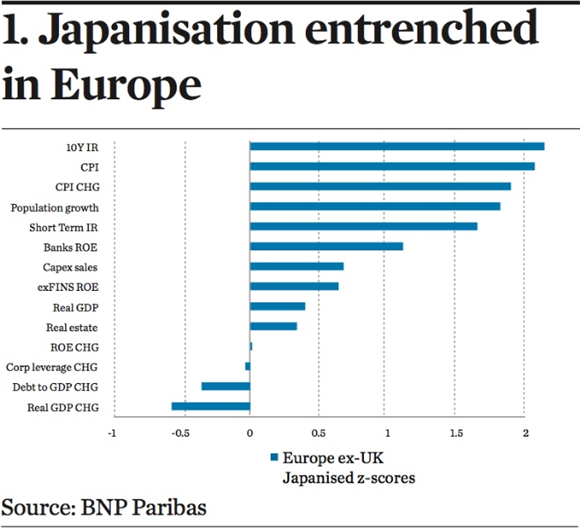In Europe Parallels to Japan s Lost Decade
Post on: 28 Июль, 2015 No Comment

By Mark Scott May 3, 2012 8:27 am May 3, 2012 8:27 am
Hannelore Foerster/Bloomberg News The European Central Bank in Frankfurt.
LONDON Is Europe the new Japan?
Parallels abound between Europe’s current debt crisis and Japan’s so-called Lost Decade, when the Asian country’s economy imploded in the 1990s.
Both regions experienced real estate booms ahead of their financial crises, consumers took on large levels of debt and domestic banks built up unsustainable loan-to-deposit ratios as they sought to feed local demand for borrowing.
Recently, analysts at Barclays examined whether Europe’s debt crisis would affect local banks the same way that Japan’s economic downturn hurt that countrys financial institutions.
Their conclusions are not happy reading for European banks, which are trying to pare back lending, increase capital reserves and reduce risky trading activity in investment banking units.
Many of the Continent’s largest financial institutions have recently reported weak first-quarter earnings. Last week, Deutsche Bank of Germany announced a 34 percent drop in net profit, to $1.85 billion, while the Swiss banking giant UBS said on Wednesday that income for the first three months of the year fell 54 percent, to $911 million.
For the Barclays analysts, more pain may be on its way. In both Europe and Japan, the stock performances of local banks during each regions crisis have been remarkably similar.
Before the downturns, the analysts wrote in a report on Thursday, financial institutions represented roughly 20 percent of the total value of their countries’ stock markets. Six years into each crisis, the combined value of the banks had declined to just 10 percent of the local exchanges.
If the similarities between Europe and Japan continue, investors could be on the look out for even worse share price performance, the analysts said:
“However, perhaps the more worrying thought is what happened next. After halving relative to the market between 1993 and 1999 as European banks have now done since 2006 the Japanese bank sector subsequently went on to underperform the wider market by more than 40% to trough at 6% of market value. Although they did recover some ground in the early 2000s, prior to the onset of the current financial crisis, they are currently still a quarter below their level six years post their peak a stage Europe is at today.”
Another interesting potential parallel between Europe and Japan involves government debt.
Before the Asian country’s economy crashed, sovereign debt represented just 6 percent of Japanese banks’ balance sheets. But as the firms pulled back from funding the private sector to reduce their risks, government debt as a percentage of banks’ overall balance sheets ballooned to 23 percent as of 2011.
In Europe, a similar increase in bank ownership of sovereign debt, particularly from riskier countries like Spain and Italy, is also likely to happen, according to the Barclays analysts.
The European Central Bank has lent local firms more than $1 trillion in low-interest loans in recent months under a program called the long-term refinancing operation, or L.T.R.O.
Banks, whose government debt holdings currently represent about 4 percent of their balance sheets, have been busy buying high-paying government bonds.
This so-called carry trade of using low-interest European Central Bank money to buy high-interest sovereign debt can be profitable, but it leaves firms exposed to the possibility of European countries not being able to pay their debts.
According to the Barclays analysts:
The recent L.T.R.O. and subsequent carry trade apparently conducted by several banks might be considered the start of a process of making the balance sheet become “more Japan-like.”














